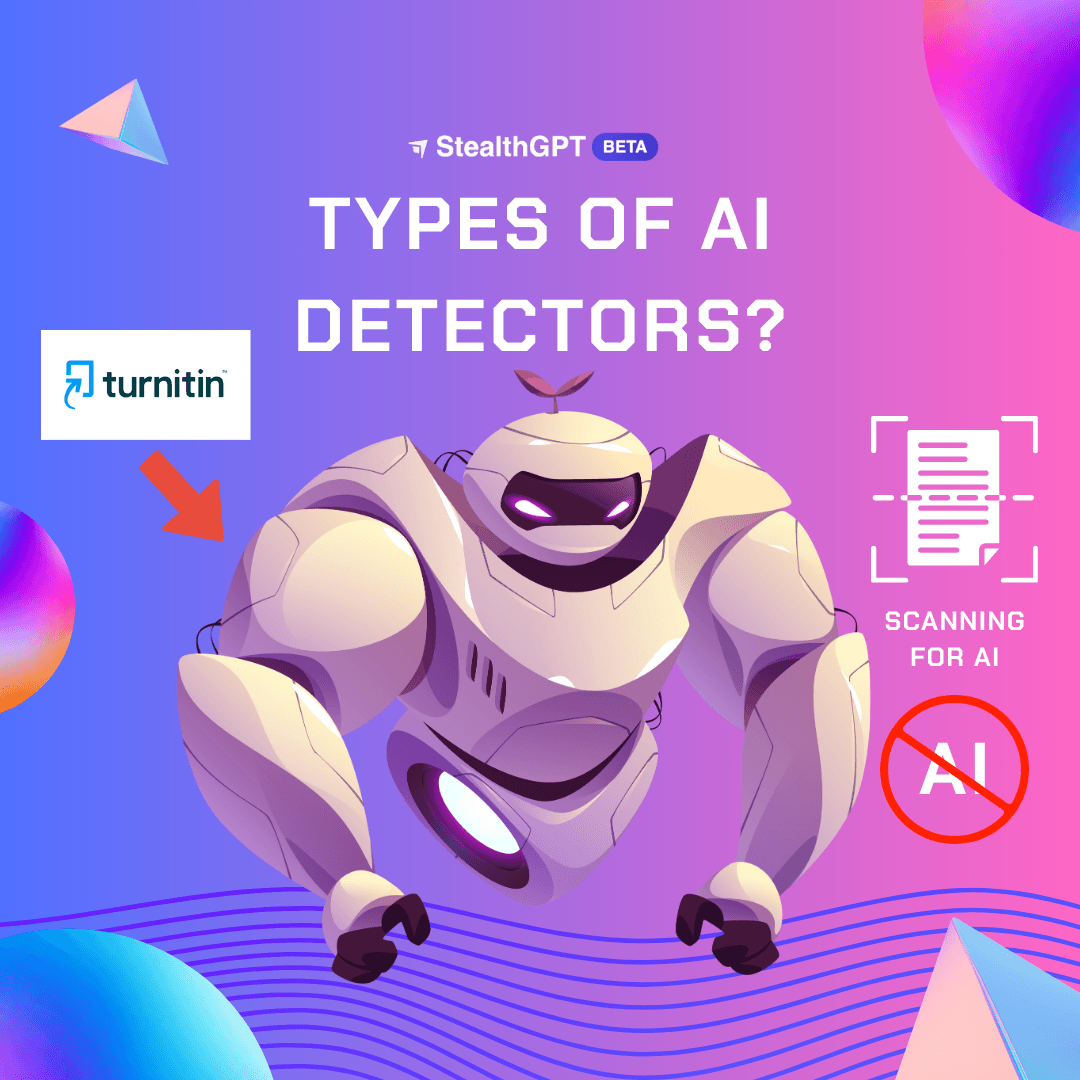Blog, AI Detector
Types of AI Detectors You Need to Know
There are two sides to the rising prevalence of artificial intelligence (AI) in content creation nowadays.
On one hand, using AI writing assistance tools to create content is becoming popular because it saves tons of time for humans but still ensures quality. Since this type of content can be quickly made in the blink of an eye, so people will have more free time to do other activities that they want.
On the other hand, writing content with the help of AI writing tools is also seen negatively. This is because people will eventually stop learning how to write naturally by themselves, and AI-generated content sometimes lacks creativity, personality, context, and reflects factual accuracy.
As a response, AI content detectors were born to tell the difference between human-written content and AI-generated text. In this article, we will learn more about AI detectors and highlight some of the best, most widely used tools in the the field.
Table of Contents
TL;DR
What Are AI Detectors?
Who Uses AI Detectors?
Are AI Detection Tools Worth It?
Can AI Detectors Be Wrong?
Top 10 Best AI Content Detectors To Spot AI-Written Text In 2024
Frequently Asked Questions
Wrapping It Up
TL;DR
In a hurry? Here is a quick summary section for the best AI detectors in 2024.
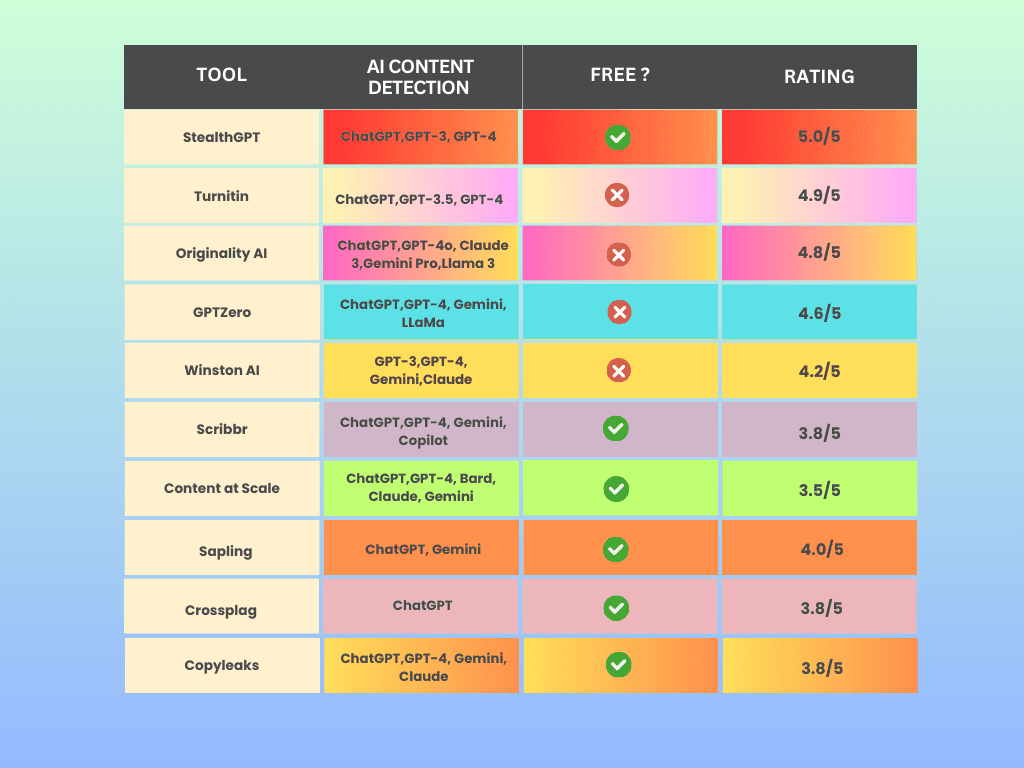
What Are AI Detectors?
First of all, let’s figure out what AI content detection tools are all about. To put it simply, AI detectors are tools that are designed to find out if the content is real or AI-written text.
The tool applies sophisticated algorithms and machine learning models to automatically extract and classify different specific attributes or characteristics of the content (such as ChatGPT, Bing Chat, Claude, Google’s Gemini, etc, or any type of digital content) and then issue a detailed report that includes how much percent of original and artificial content involved.
There are mainly two types of AI content detectors, which are:
Rule-based AI content detectors
Machine-learning-based AI content detectors
The first type is set by using predefined rules in identifying AI-generated content while the other type is applying data-driven algorithms. In general, rule-based detectors are faster but may give more false-positive results, whereas machine-learning ones are more flexible but require more computing resources and data.
How do AI Detectors Work? Everything You Need to Know
Who Uses AI Detectors?
AI detection is a helpful tool for anyone who is currently working in the writing and content marketing industry, from a book publisher, journalist, or ghostwriter to an SEO specialist. Moreover, many schools and universities have also made use of these tools to prevent cheating from the production of essays written by AI instead of a proper and ethical research process from the students.
AI detection tools help them to spot potential plagiarism, false information, and academic fraud. Also, if a text is flagged as AI-written text, then it means that the content itself needs to be rewritten and restructured to have a more natural feel to the readers, ensuring that their liking for the text will increase.
But outside of the fields mentioned above, there are lots of other industries that could benefit from AI detector tools, which include:
Healthcare and Medical Institutions
Manufacturing and Quality Control
Law Enforcement and Government Agencies
Financial Institutions and E-commerce Companies
Cybersecurity Firms and IT Companies
Are AI Detection Tools Worth It?
AI content detection tools are worth using because they will help to make sure that your content is authentic and trustworthy and avoid any risks that might arise from AI-generated scripts.
Here are other reasons why it was useful:
Preventing Google from flagging AI content as spam
Improving SEO performance and SERPs
Ensuring originality, authentic content, and boosting credibility
Limiting the publication of low-value texts or false information
Can AI Detectors Be Wrong?
Yes, there are many examples of detectors that could not pick out AI-generated text, and many other times, when they flagged human copy as AI copy (called a false positive and false negative). This is largely because the tools are based on probabilities, and the different detectors use different datasets of content with which to train the AI tools. So, at times, they can also give different results from one another.
In those circumstances, you can damage relationships if you wrongly accuse a student or employee of using AI content generation rather than writing that copy themselves. And it's pretty sure that you can find no AI detector on the market that can claim that they can predict the text to 100 percent certainty.
So, to put it briefly, there are two things that you need to take into consideration when using AI detector tools to detect AI writing.
1. Don’t believe any of these AI detector tools 100 percent of the time. No AI detection tools work perfectly, even if they’re extremely accurate in picking up certain kinds of content.
2. Do not forget to read the tool’s documentation to verify that when the results come back, they really do mean what you thought they meant. Often, it is obvious, but not always.
Top 10 Best AI Content Detectors To Spot AI-Written Text In 2024
#1. StealthGPT
StealthGPT’s AI Detector is designed to identify text created by artificial intelligence. The AI Detector gives a probability score about the chance of the content being written by AI writing tools or a chatbot. All users need to do is simply copy the text content and paste it into the text area for detailed analysis.
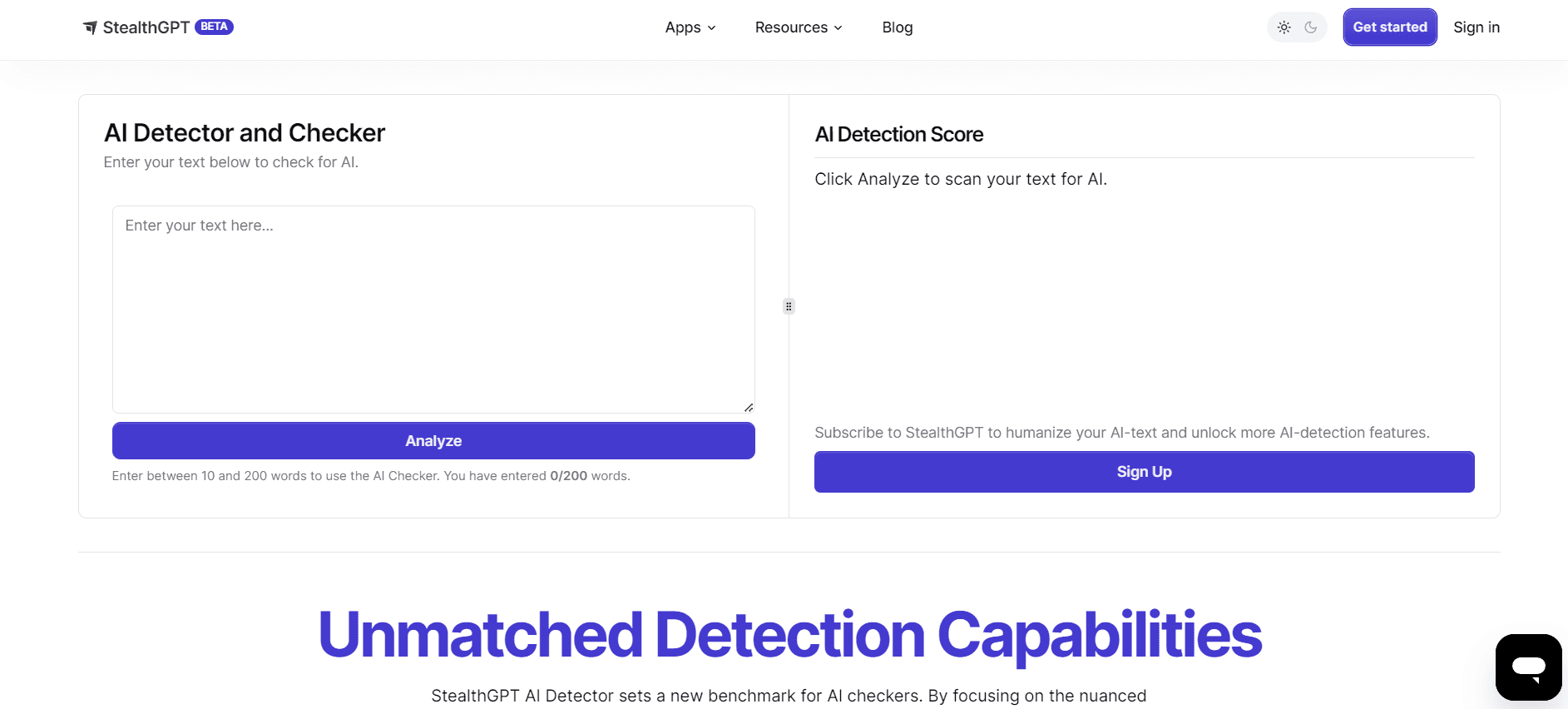
With the most accurate AI Checker in the industry, it doesn't matter if your generative AI text is from ChatGPT, GPT-3, GPT-4, or Bard. Our free AI detection can provide unparalleled detection accuracy as well as a robust safety net for your articles against intruding machine-written content.
With StealthGPT’s AI detection tools, you can ensure the authenticity and originality of all your content and even influence your search engine rankings.
Key Features
AI content detector and checker
Pricing
Free to use up to 200 words
Essential: $17.99 per month for 750 input words and 100,000 words per month with access to StealthGPT's other features
Pro: $24.99 per month for 1,500 input words and 500,000 words per month with access to StealthGPT's other features
Exclusive: $34.99 per month for 2,000 input words and 1,000,000 words per month with access to StealthGPT's other features
#2. TurnItIn
Turnitin is a well-known originality-checking and plagiarism-prevention service worldwide that is used to check your writing for citation mistakes or inappropriate copying.
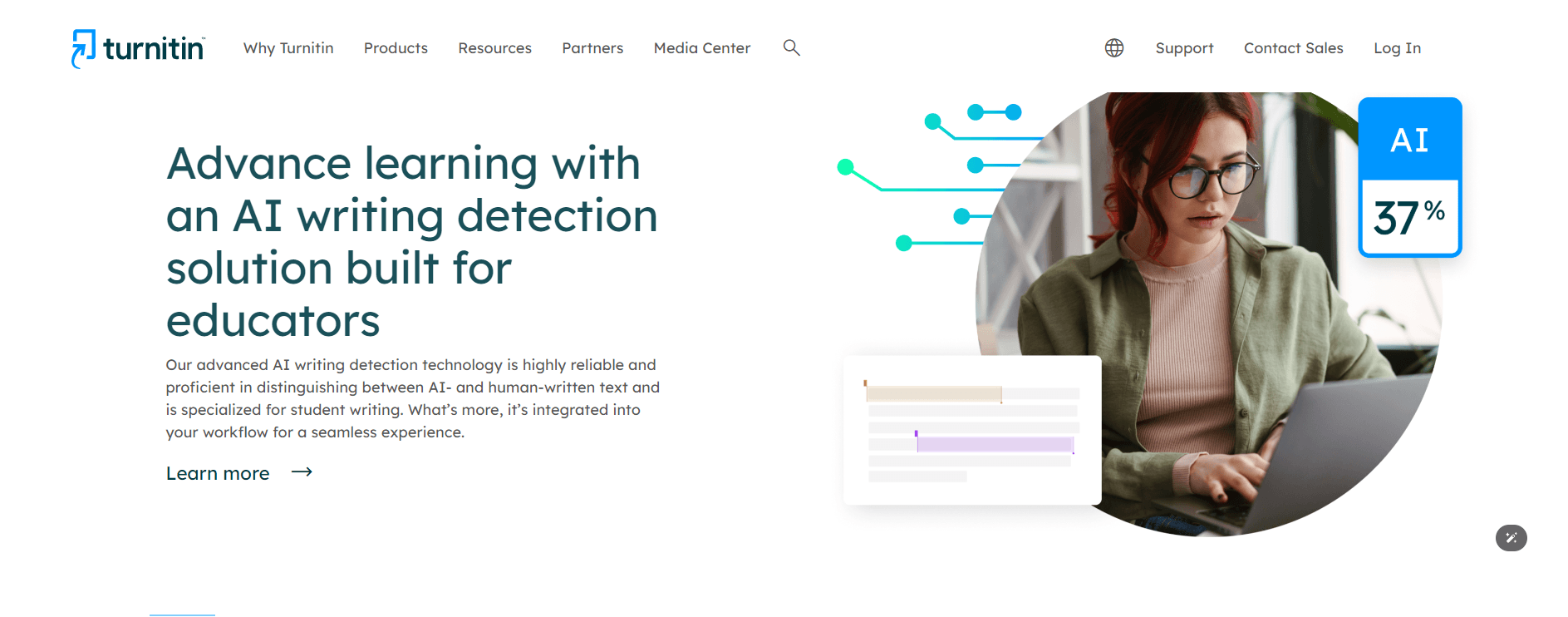
When you submit your paper, Turnitin compares it to text in its massive database of student work, websites, books, articles, etc., and then provides a real-time similarity report on how many percent of the originality score your paper receives. This method helps to ensure the integrity of academic writing in global education and research.
However, with the rise of ChatGPT and AI-generated text in 2022 has pushed Turnitin to roll out an AI writing detection feature in April 2023 to help educators catch and identify students who attempt to cheat by using AI writing tools in their submitted work.
Turnitin's AI detector is specialized for student writing and is highly proficient in distinguishing between AI-generated content and human-written text.
Key Features
AI writing detection
Plagiarism detection
English language only
Pricing
Turnitin Instructor account: $49.99 for a one-year subscription
#3. Originality AI
Originality AI is an AI-powered content detection and analysis tool that was built to help writers, content creators, and publishers to screen their content for its originality.
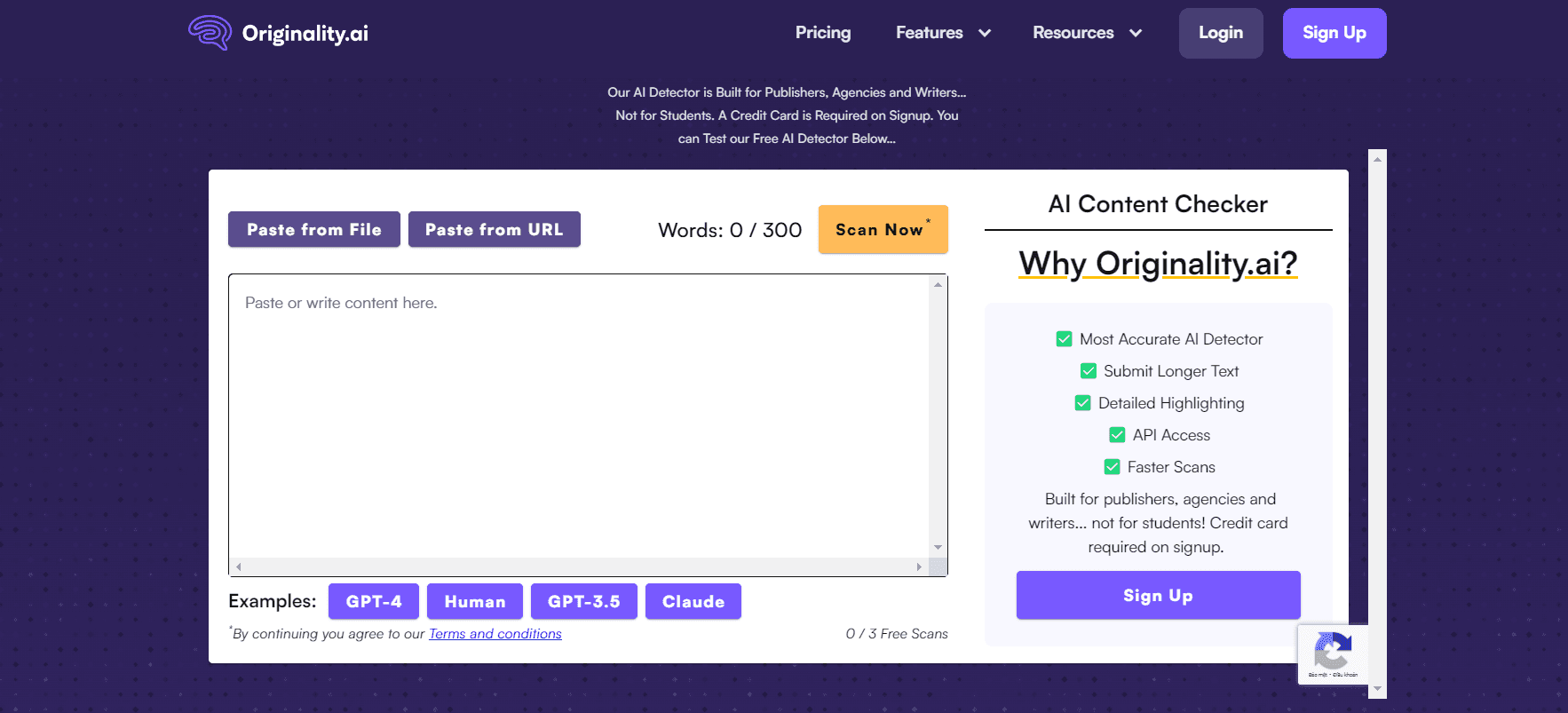
This tool is considered the second-best option AI detector on this list, and I recommend it to all serious publishers and writers out there who want to keep the integrity and authenticity of their posts by not allowing AI-generated text to be published.
Key Features
AI content detection
Originality report
Readability scan
Plagiarism checker
Chrome extension
API integration
Pricing
Pay As You Go: $30 for 3,000 credits
Pro: $12.45 for 2,000 credits per month
Enterprise: $136.58 for 15,000 credits per month
#4. GPTZero
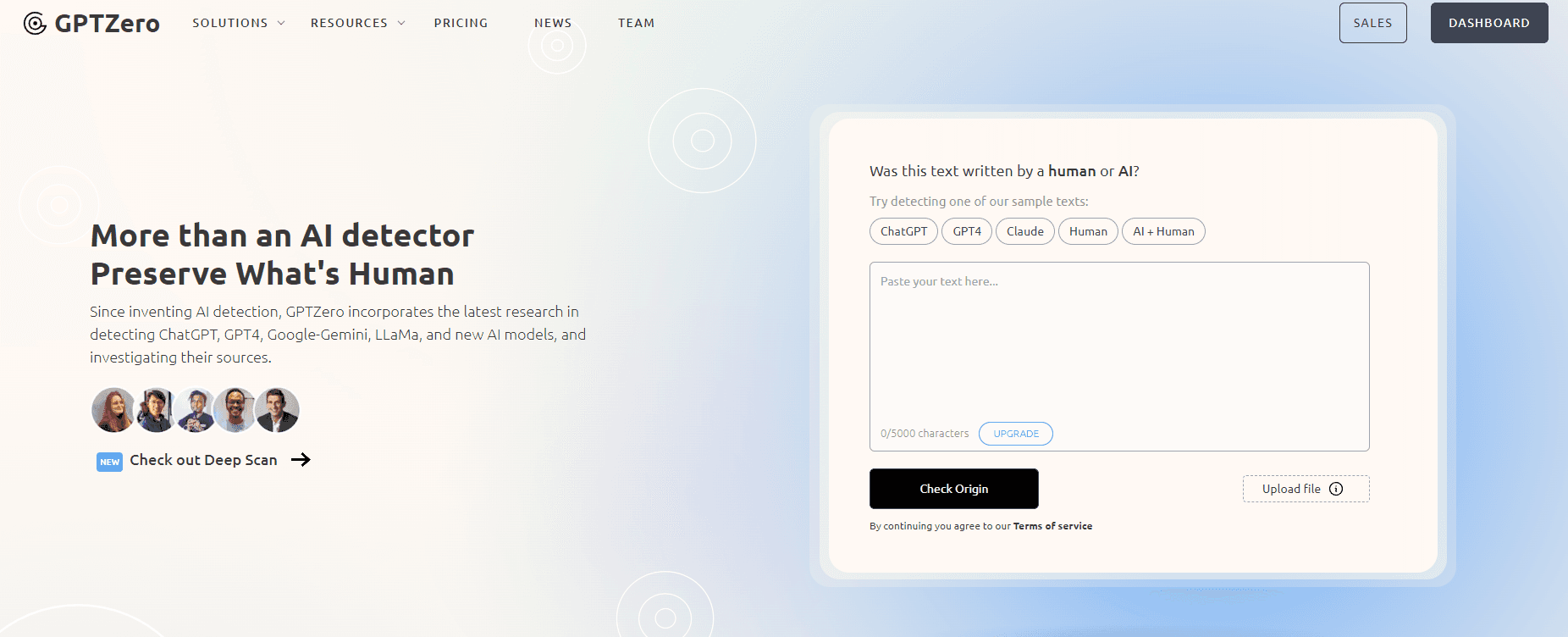
GPTZero is an AI content detection that can analyze texts generated by any sort of AI model, whether GPT-2, GPT-3, or GPT-4, Google Gemini, Claude, and any new AI models are propping up.
The tool was developed by Edward Tian, a student at Princeton University, with the main purpose of providing users with a reliable method to check whether the content was either written by a human text or by an AI writing tool. So far, GPTZero has been considered as one of the top AI detector tools on the market since its first launch online in January 2023.
Key Features
Advanced AI deep scan
Plagiarism scanning
Human writing report
API integration
Pricing
Freemium: 10,000 words per month
Essential: $10 per month for 150,000 words
Premium: $16 per month for 300,000 words
Professional: $23 per month for 500,000 words
#5. Winston AI
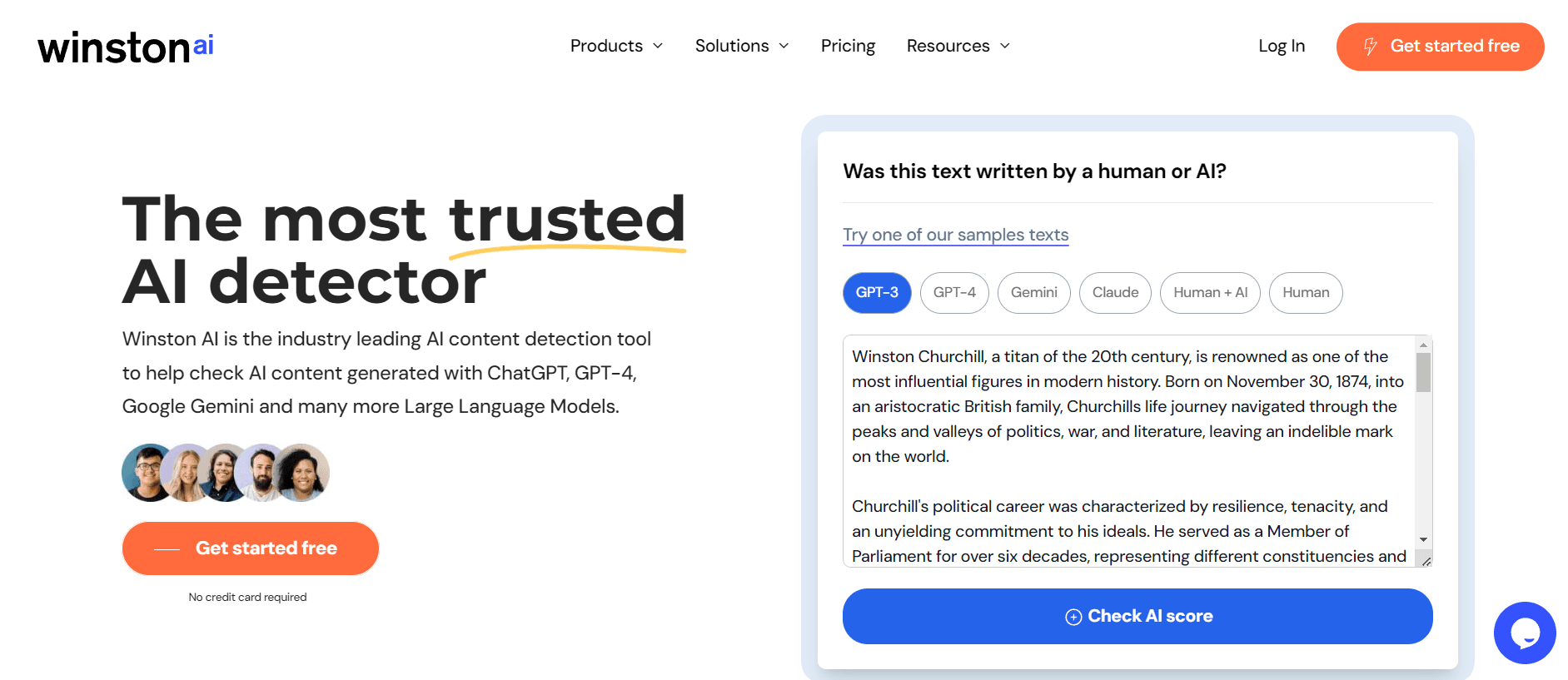
Winston AI is one of the most trusted AI detector tools that help to check AI content generated with ChatGPT, GPT-3, GPT-4, Claude, and many more Large Language Models. All you should do is simply copy and paste your desired content into Winston AI's artificial intelligence content analyzing section and hit their scanning text option.
With Winston AI, you can be sure your content stays genuine and trustworthy across all platforms. This tool is especially suitable for publishers, SEO writers, and educators.
Key Features
AI content detector
Readability score checker
Advanced plagiarism checker
AI image detection
Chrome extension
Pricing
Freemium: 2,000 credits for 7-day trial
Essential: $12 per month for 80,000 credits
Advanced: $19 per month for 200,000 credits
Elite: $32 per month for 500,000 credits
#6. Scribbr
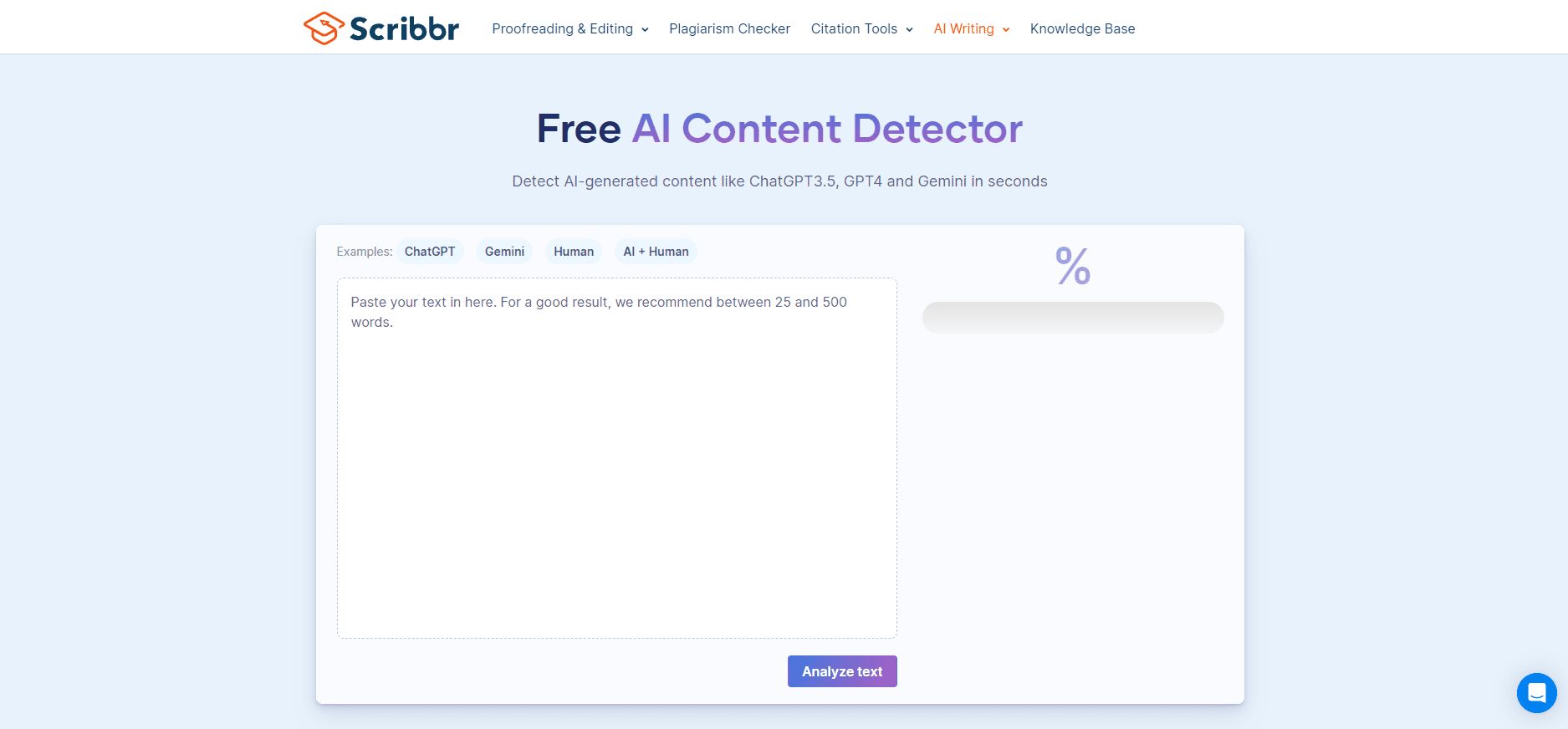
Scribbr AI Content Detector is a tool designed to identify AI-generated content, such as text produced by ChatGPT 3.5, GPT4, and Gemini. The tool requires no sign-up and is free of charge; once you click the button, it will instantly check your text for you automatically.
Since the tool is completely free, so there are no limits to the number of times you can use it. The Scribbr AI Content Detector is a great resource for students, teachers, homeschoolers, and bloggers to verify if their human-written text is 100% unique and original.
Key Features
AI content detector
Plagiarism checker
Pricing
Free to use
#7. Content at Scale
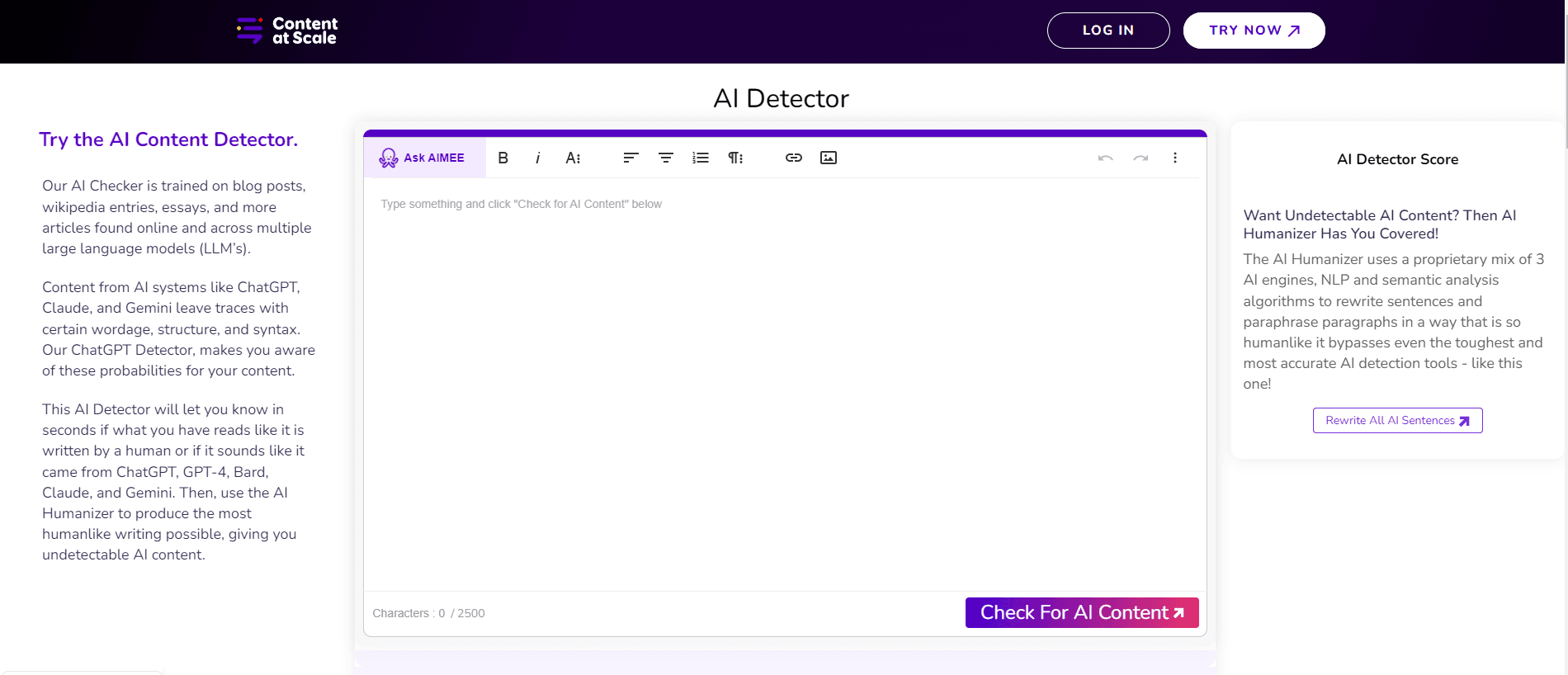
The Content at Scale AI Detector is a free tool designed to identify AI-generated content and human-written content. This tool supports very reliable AI content testing and detection by performing analytical steps and comparing them with previously verified data.
When performing a check, users can upload up to about 25000 characters at a time, and Content at Scale AI Detector will complete the scanning process quite quickly. The returned results will be the text evaluation conclusions performed by AI or humans.
However, users must upgrade to the Pro version of this tool before they can utilize the feature to display in detail where the content made with AI content detection tools is and the AI percentage of the text.
Key Features
AI content checker
Pricing
Free plan: Limit to 2500 characters
Pro version: $49 per month for unlimited scans
#8. Sapling
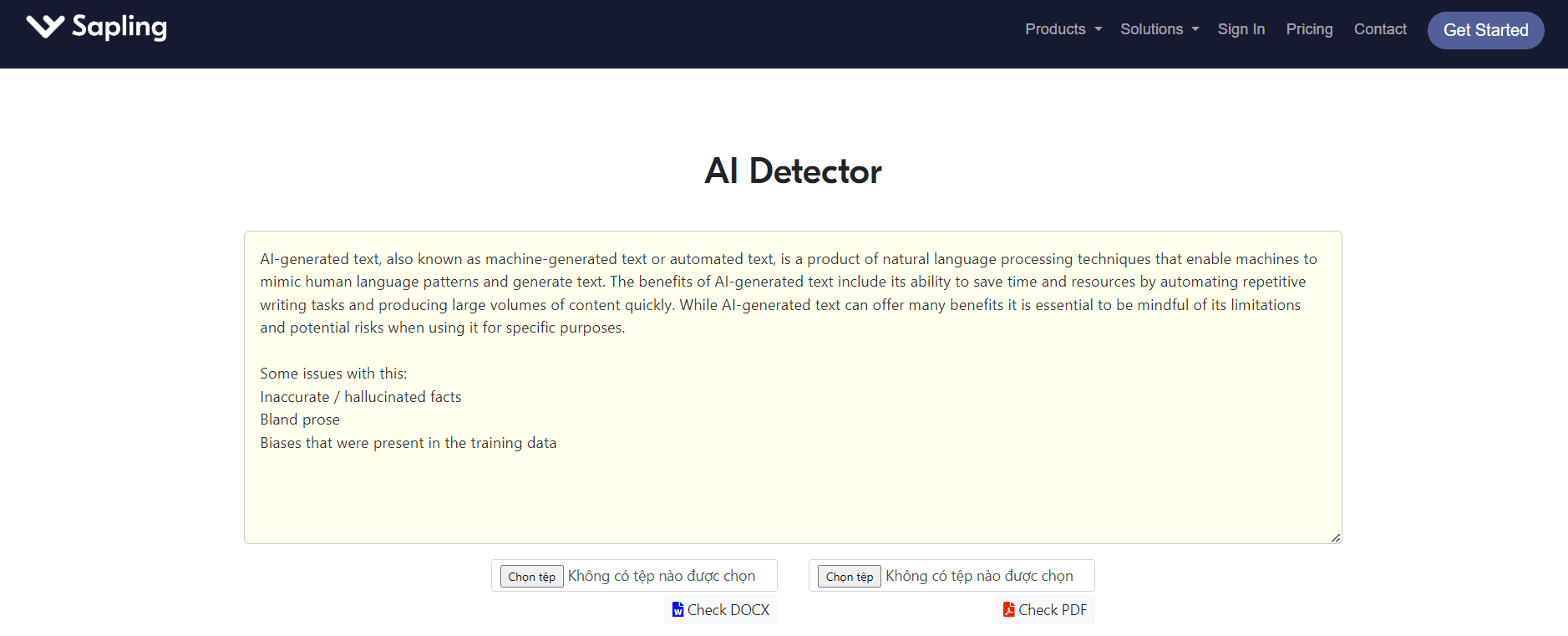
Sapling AI Detector is a product developed by the company Sapling.ai. It is a service that passes text through algorithms that attempt to determine if your content was written by an AI language model such as ChatGPT or Gemini.
This free AI writing detector tool can be helpful for educators, SEO practitioners, and any reviewers of user-generated content.
Key Features
AI content detector
Plagiarism checker
Pricing
Free plan: Limit to 2000 characters
Pro plan: $25 per month for 50,000 characters (free 1-month trial)
#9. Crossplag
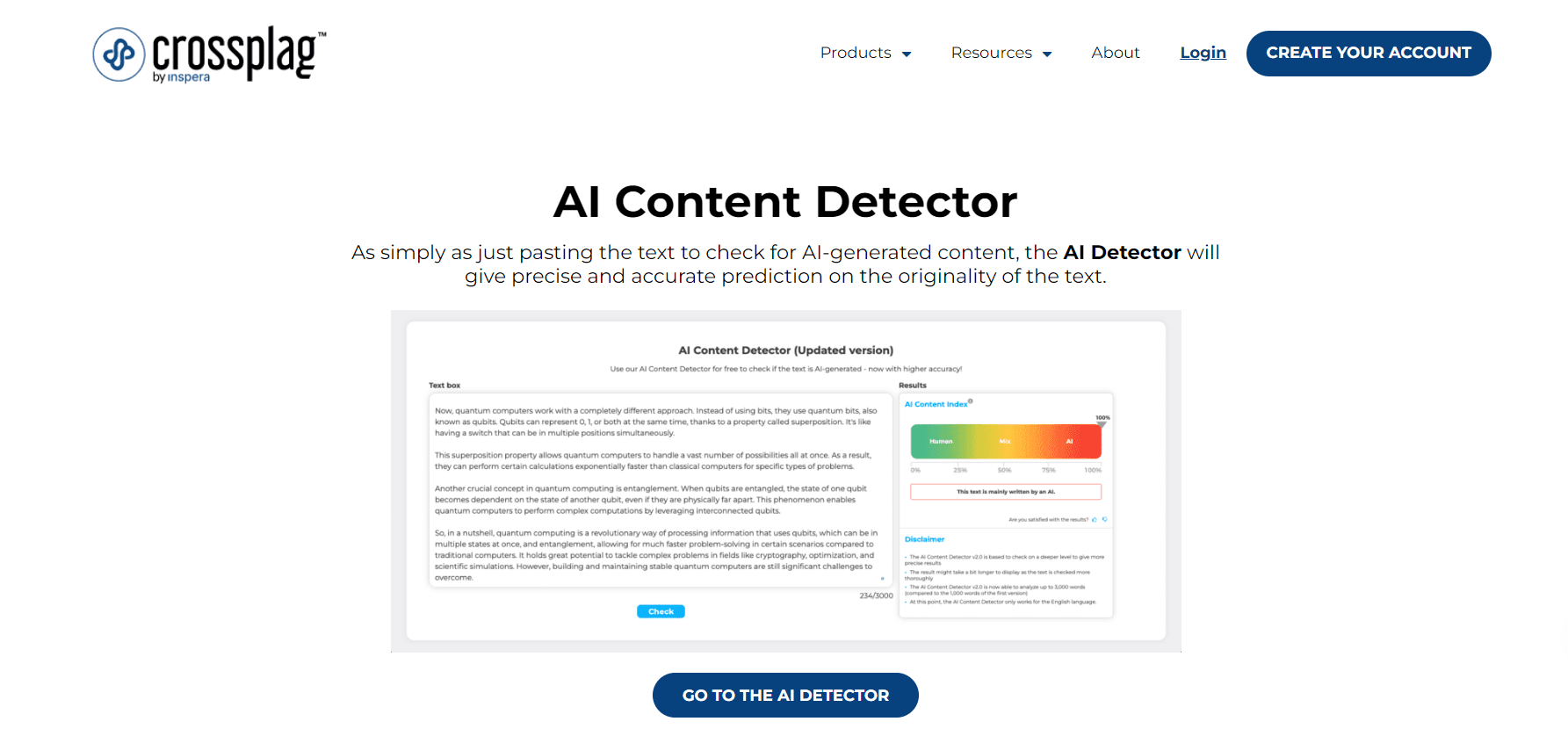
Crossplag is a widely used plagiarism detection tool that helps students, teachers, writers, and bloggers to ensure the originality of their work.
Its AI content detector is also one of its latest features recently. The tool uses machine learning algorithms to discover the origin of a text and let you know if it’s human-written or AI-generated in a double click.
If you find yourself unable to afford Turnitin or Originality.ai, which is the best premium AI detector mentioned in this list, then Crossplag could be an excellent alternative option for you to consider.
Key Features
AI content detector
Plagiarism checker
Pricing
Free to use up to 3,000 words
#10. Copyleaks
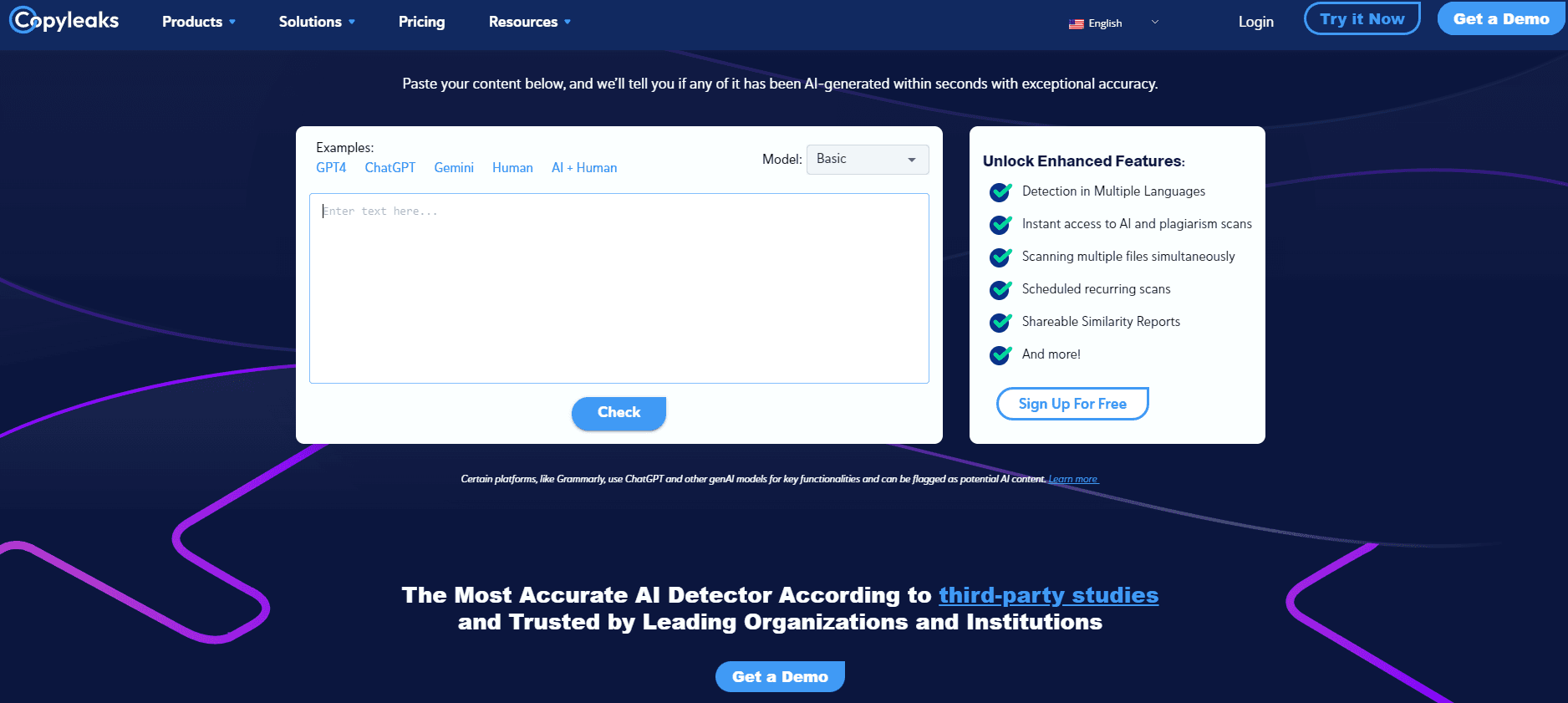
Copyleaks is the last AI detector on this list. Copyleaks uses several advanced AI content detection methodologies to detect AI-generated content and help you identify any such content on your website.
Besides, Copyleaks doesn't flag Grammarly's non-AI features, such as spell check and grammar, as AI content generation. Another AI content detector, on their own analysis, flags 20 percent of Grammarly's non-AI features as AI-generated text - while also managing a remarkable 20 percent false-positive rate.
Key Features
AI content detection
Plagiarism detection
Detection across 30 languages
API Access
Pricing
Free plan: Limit to 350 characters
Paid plan: $7.99 per month for 1,200 credits
Frequently Asked Questions
Q.1. How Do AI Detectors Work?
AI detectors ingest training data, which is usually a set of articles that are supposed to be a mishmash of human and AI-created text. They then figure out which characteristics best identify the algorithms’ work in the AI-generated pieces.
Two of the most important features that AI detectors usually analyze are:
Perplexity: The unpredictability of the content.
Burstiness: Variation in the length and structure of the sentences.
Q.2. How can I detect AI writing?
AI detectors are looking for a low degree of variability or randomness in terms of word choices or sentence length, generic or impersonal tone, unnatural word usage, and perfect grammar and spelling for instance – all of which is typical of AI writing from ChatGPT.
Q.3. What is the best ChatGPT detector?
All of the AI content detection tools that have been mentioned in this blog post (in numerical order) are considered top-notch tools that offer not only ease of use but also remarkable accuracy in flagging plagiarism, AI writing, and general unoriginality in text. Whether you are a student, teacher, or professional writer who wants to ensure that your content is genuine, authentic, and plagiarism-free, you can consider this list as a perfect reference for use.
Q.4. Can AI detectors be fooled?
Luckily, the answer here is Yes. AI detectors can be tricked or bypassed by several methods, such as adding "perplexity and burtiness" into your content, avoiding "repetitive keywords and phrases", rewriting them, and putting a personal touch into AI written text. However, it takes tons of time to edit manually.
Q.5. What is the best way to outsmart an AI detector?
Well, the easiest and most effective way to make your AI content non-detectable and sound like human-written content is to use StealthGPT - an anti-AI detection tool. StealthGPT will definitely give you more peace of mind if you are looking for an incredible tool that you can rely on when checking hundreds of sites every month, including Turnitin (the hardest server to beat), without being detected.
Q.6. Can Google detect AI-generated content?
Google doesn’t have a problem with AI-generated content; it only has issues with content that offers no value to a reader. However, Google and other search engines can identify content generated by AI content generation.
Google will flag any AI content designed specifically to boost search rankings. According to Google’s Search Central, spammy AI content includes:
Low-quality AI content offering no value to readers
AI content published without a human checker
Content that doesn’t make sense to readers but includes SEO keywords
AI content that doesn’t have concern for reader experience
In a nutshell, according to Google’s policy, the origin of the content is not an issue; the problem is if the generated content lacks quality and has been created to manipulate the search algorithm. Therefore, if you create meaningful and informative content, there will be no need for Google to demonatize or derank it.
Wrapping It Up
To summarize, AI-generated content went along with AI detectors as artificial intelligence technology became more integrated into our daily lives, and AI content detection tools also became a very useful method to keep quality content on the ground.
There are many AI detectors on the market that offer different functionalities and payment plans. Therefore, no matter what your needs are and what your industry is, you will probably find the right detection tool that suits you best.
Keep in mind that there is no perfect system and it's really important to know an AI Detector's limitations as well - all you can do is use it with a thorough review, discernment, and sound judgment, and then the output will be fine.
